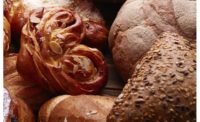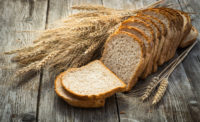Ingredients and processing play a 50/50 role in the quality production of artisan bread. It’s the simple ingredient list and simple processing that is helping boost this style of bread’s popularity in the natural and clean label trend. I addressed the ingredients side in my last column in the March issue (see “Ingredient functionality in artisan bread production”). In this column, I will examine the other 50 percent: the process.
Mixing. Great artisan bread dough starts at the mixing step. Mixing is a complicated but a necessary step in any industrial bakery. It blends, disperses the ingredients, and it hydrates the damaged starch and gluten. Once the gluten is hydrated, it entraps air bubbles. Mixing also kneads and develops the dough, providing that much-needed foundation for a network that results in a good volume. Lastly, mixing is the only step that provides a uniform distribution of cell structures.
The amount of mixing time really depends on your dough system:
- Straight or no-time doughs have the longest mixing times
- Using a sponge or biga can reduce mixing times by as much as 25 percent, as long as this preferment is used at a higher percentage
- Sourdoughs or starters with a long bulk fermentation that lasts over 4 hours can reduce the mixing time by 50 percent
Fermentation. Fermentation is the next-biggest factor in the quality of artisan bread production. Besides providing the gas for leavening of the dough, fermentation has other tertiary functions, as well. It’s responsible for:
- Dough hydration
- Dough relaxation
- Machinability
- Production of acids
- Production of enzymes
- Production of alcohols
In straight dough, bulk fermentation can exist in the autolyse step, which can often last from 15–60 minutes. Though fermentation is not the intent of autolyse (it’s hydration), it’s still an important physiochemical step in the artisan bread making process (see “Autolyse” on BAKERpedia.com for more information).
In artisan sponges and doughs, fermentation is usually from 4–8 hours. Some industrial sourdough bread may use overnight ferments. We often see variability in the length of the fermentation time. It just depends on how much time and space you have.
Traditionally, fermentation of wheat or rye sourdough ranges from 4–48 hours. During this time, lactic acid bacteria can degrade gluten proteins in sourdough, which is helpful for gluten-sensitive individuals, potentially aiding digestion. Depending on the total fermentation time, a longer fermentation of more than 8 hours provides the ability to use a weaker flour like winter wheat with 10 to 11 percent protein.
All in all, fermentation improves the hydration of the dough, it relaxes it, and makes it more machinable. During fermentation, acids are produced together with enzymes and alcohol (see “Ask Dr. Lin Episode 28” for more on this process).
Bulk fermentation. So should you be carrying out bulk fermentation? After all, who doesn’t want higher hydration and larger yields with less yeast, shorter mixing times, a cleaner label, better texture, and a rich aroma? However, be aware that this requires more vats and space, which can require more capital. The breakdown and cleanup of sponge brew equipment requires extra sanitation resources. Also, a longer process can make it more difficult to insert last-minute customer orders.
Molding and shaping. After bulk fermentation, the artisan loaves are shaped into their final form. This happens in the make-up department. The purpose of the make-up department is to make sure that the final loaf is shaped consistently before its final proof. This department includes the equipment that handles the following:
- Dough dividing
- Dough rounding
- Sheeting
- Forming
- Panning
While many bakeries still move a significant amount of bread by hand because they don’t like the quality of automation for this step in the artisan baking process, suppliers have developed stress-free equipment suited to these tasks. The equipment may be costly, as most equipment is, but they have the ability to produce high outputs with a nicely open crumb. So, if you are stressing out your system, think about automating this part of your baking process.
Final proof. This step is extra crucial for the quality of the loaf, because it will affect the size of your loaf and the ultimate quality of your product. The final proof for many artisan breads needs to be around 60–90 minutes. This is the biggest challenge for most high-volume bakeries, because there may not be enough space to accommodate this long proofing time. Remember, you should be working at 95–100°F (35–37°C) and looking to proof your loaf to the right height. Investment into the right proofing system that can handle a wide range of proofing times or have bypass zones is critical to producing a high-quality artisan loaf.
Scoring. Before entering the oven, the loaves have the first be scored. This requires a cut on top of the loaf that will expand in the oven. Some bakers use scoring techniques that result in a beautiful artisan design. Instead of blades, you should look for water scorers that are fully automated. They are able to perform different cuts at different speeds. Scoring helps people identify different types of bread, controls breaks during oven spring, and affects the final volume and crust.
The bake. After scoring, you must bake immediately to prevent further loss of the gas. The journey from the final proof to the oven must be smooth. Therefore, smooth floors or conveyors are crucial at this point. In the oven, the crust will first form with the gelatinization of the starch on the surface. Not more than 10 seconds of steam is required at this stage.
Industry suppliers offer relative humidity loggers that can monitor humidity levels in the oven to help you with this process. In the oven, caramelization and the Maillard reaction happen in the second to fourth zones of baking. Enzyme, yeast, and bacterial activity is stopped at 140–185°F. It is of great importance that you reach this temperature. Remember that starch gelatinizes at 167°F, reducing any free water in the dough, solidifying the network and creating the crumb.
Every hydration level and loaf size will have different baking requirements. The core temperature of each loaf should reach 198–203 °F, measured by using thermal profiling. The thermal profiler should produce an “S” curve that profiles the interior of the bread loaf as it travels through the oven (see “Thermal Profiling for Baking” on BAKERpedia.com for more information).
Why is this important? Even though you may reach 200°F when the loaf exits the oven, you don’t know how long it resided in that bake out zone. The time spent in the bake out zone needs to be no less than 85 percent of your bake time. Many bakers get this wrong and overbake their breads, sometimes causing the breads to go stale too quickly. Why do you think artisan breads stale so fast? Because artisan bakers don’t have eyes on this part of the process! Use a thermal profile, and increase your shelf life through this process.
The best baking time and temperature for each product can range anywhere from 18 minutes for baguettes to over 30 minutes for boules. Remember, you need to manipulate your oven zones to hit the 85 percent benchmark on your thermal profiles. If you’re hitting it at 70–75 percent, then you are overbaking the bread by keeping it at 25–30 percent in the bake out zone. Here are some suggested baking times:
- Baguette, 12 oz.: 18–25 minutes
- Ciabatta 12 oz.: 20–28 minutes
- Bâtard 16 oz.: 22–28 minutes
- Boule 16 oz.: 24–30 minutes
Cooling. A common mistake that artisan bakers make is over-cooling. If bread is cooled until it’s time to package, it hardens up and loses moisture after the first hour. Then, it starts collecting mold spores. It is important that you cool to an internal temperature of 104°F, then slice and package. Remember, cooling is dependent on the temperature of bread coming out of the oven, the relative humidity of your air, and the air temperature of your cooling room. Don’t forget to use gloves and good packaging with proper sanitation in this area so that you can get a longer shelf life.
Among all the points stated above, fermentation is the most-important factor in keeping the products consistent. Fermentation parameters are key in controlling quality, and a trained workforce with some automation is key to producing consistent artisan bread products. And don’t forget to employ proper sanitation in your bakery. Then you should be well on your way to producing quality artisan bread!






